
In this Yeast and Sugar Science Fair Project, we’ll watch yeast feed on sugar to fill a balloon with air. A fun science project for kids that’s with household, everyday materials.
Our Inspiration
I’ve been baking bread just about every day for the past three weeks (nothing too crazy since it’s all done in the bread maker), but last week my 3.5 year old and I got into a discussion about the properties of yeast.
We like to tinker and experiment — big surprise, I know — and decided to see what would happen if we mixed yeast with warm water.
My preschooler took this job very seriously, poured the water into a bowl, added a couple teaspoons of yeast, and waited a few patient minutes before she said, “it makes a brownish color.” True, and to make it bubble like it does in bread, we needed to activate it with sugar.
What’s so great about an experiment like this is that it’s easy to do with household materials, and it’s ripe for authentic child-generated questions and observations. When I asked what she thought would happen if we added sugar to the yeast she said, “I don’t know! Let’s mix them and find out!.”
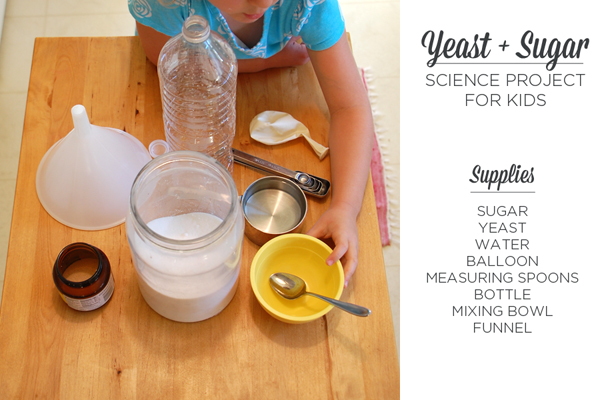
Supplies: Yeast and Sugar Science Fair Project
- Sugar, 2 tablespoons
- Active Dry Yeast, 1 packet or 2 1/4 tablespoons
- Balloon
- Warm water (105-115 degrees F, 40.5-46 degrees C)
- Mixing bowl + funnel
- Bottle that you can fit a balloon over
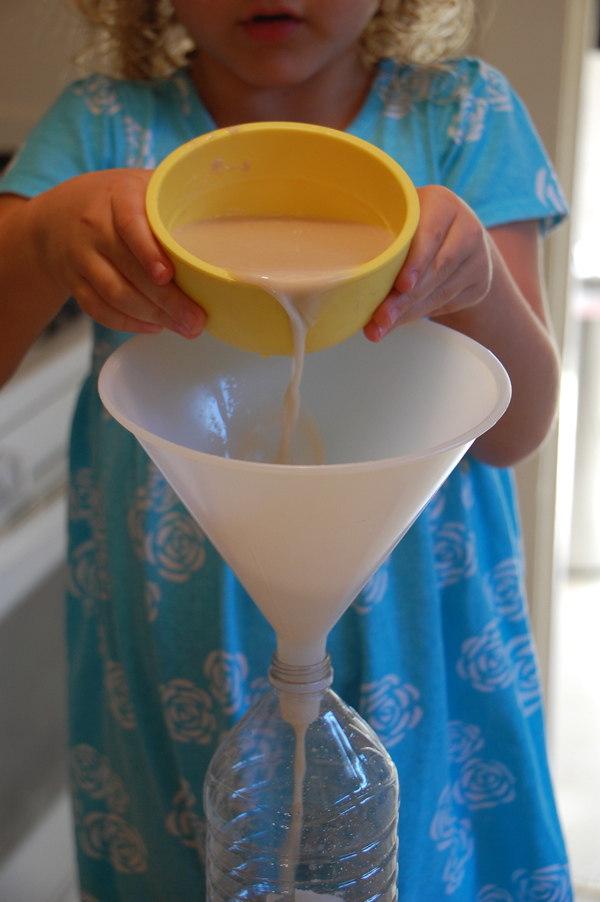
Mix the yeast and sugar into the warm water and stir. I noticed that N was sniffing the concoction and asked her what it smelled like. She said “poop.” I could see what she was saying. Consider yourself warned.
Once it all dissolves, pour the mixture into the bottle and cover the bottle with the balloon.
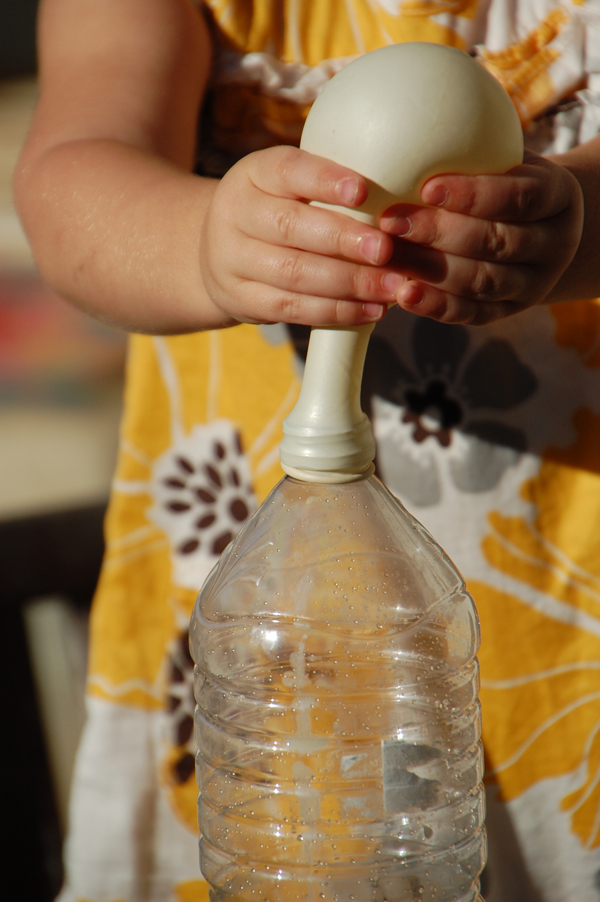
After a few minutes you’ll be amazed by something like this!
Will it blow off the bottle?
N wanted to feel it as it filled with air. She noticed the balloon was getting bigger and wanted to know how big it would get, wondering out loud, “will it fill up all the way and blow off the bottle?”
Good question!
My handy-dandy ship captain sister (no joke — that’s her job!) was visiting, and put herself right to work as chief measurer.
Move it to a safe spot
Once the bottle filled up completely, we moved the whole yeast sugar experriment to the sink. The bubbles were slow-moving, and there was nothing to worry ourselves with, but N enjoyed pulling the balloon off and watching the foam slowly pour over the bottle’s top.
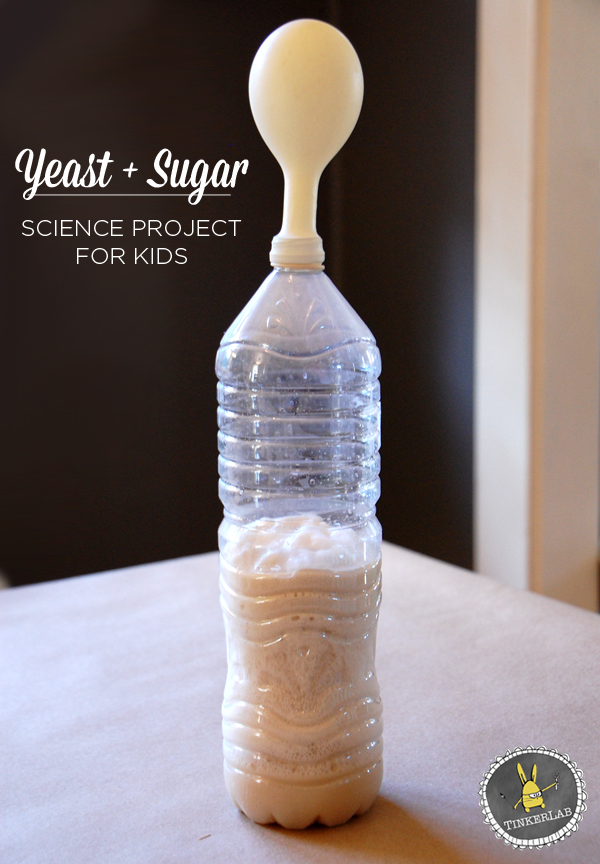
Ideas for Extending this Experiment
As we went through the process, I thought of a few fun extensions for older kids or those who want to take this further. You could play around with food coloring/liquid watercolors, have a few bottles going at once and compare the results of different sugar:yeast ratios, or compare the results of different water temperatures.
I found my recipe at The Exploratorium’s Science of Cooking series, where we also learned that as the yeast eats the sugar it makes carbon dioxide, which is essentially the same process that yeast goes through in our bread dough.
Mmmmm. I’m off to eat some whole wheat cranberry walnut oat bread. Toasted. With butter and Maldon salt. How do you like your bread? And have you played around with yeast concoctions?
More Science Experiments for Kids
If you enjoyed this project, you’ll love this article: Science Fair Project Ideas.

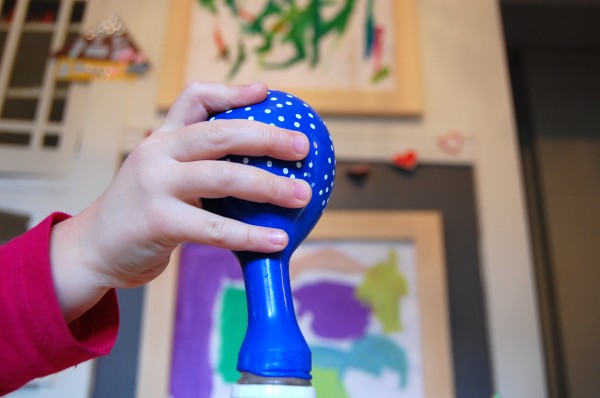
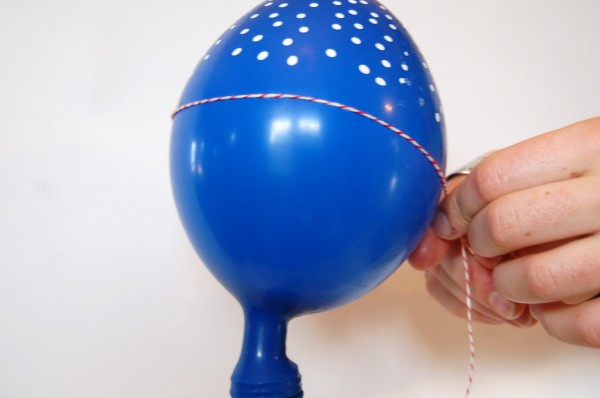
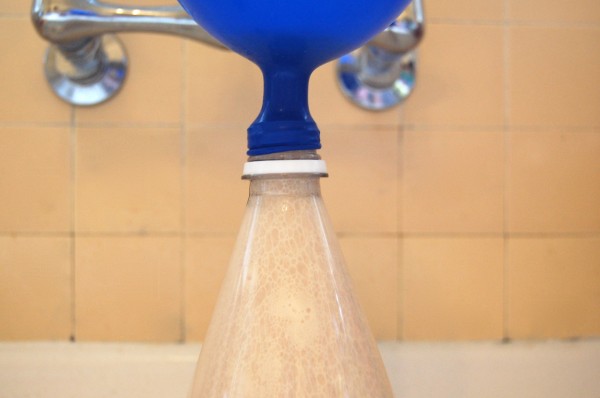
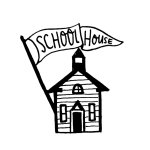
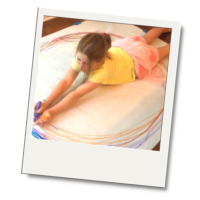
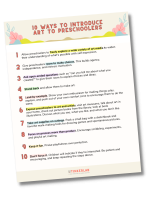
What a great idea!!
Thanks, Deborah 🙂
thank you soooooooooooooooooooooooooooo much for this info
hey
Hey
I used to bake a lot of bread with my boys when they were younger (pre-celiac diagnosis) and they always loved my scientific explanation of why the bread rises: the yeast eats the sugar and farts. 🙂 That’s what all the bubbles are, of course!
Yep, farts would be another not-so-pretty way to describe this process. Between that and my daughter’s description, I’m not sure if anyone will want to try this themselves 😉
we love yeast! my son thinks of yeast as little pets. here is our experiment we did a few months ago. it seems to come up ever year or so. great post!
http://mamascouts.blogspot.com/2011/09/science-experimentwake-up-yeast.html
Thanks for sharing your yeast experiments, Amy! I love them, and we have to try this with maple syrup next time (if I can convince my MS-adoring family to part with it first!).
way cool! you know I like to tinker as well with my girls – this will be something we can easily do at home.
I pinned this! 🙂 thanks for sharing!
Thanks for pinning it, Bern 🙂 And yes, I can totally imagine your two little scientists going crazy over this one!
This is the best blog for experiments! Thanks for sharing all your great ideas. Â Linking up to it in a science for preschoolers post.Â
Hi Kristin, Thank you soooooo much for the kind words about Tinkerlab. And thanks for sharing us with your readers….feel free to send me a link if you’d like and I’ll share it on Facebook.
This is so fun! We did this today and the kids loved it. Thank you!
awesome, lindsie! i’m thrilled to hear it was successful. thanks for taking time to give me this update.
hi robert
Hmmm…sugar, yeast and water…also known as Kilju or sugar wine!
https://en.wikipedia.org/wiki/Kilju
As well as CO2, yeast and sugar also produces Ethanol (alcohol). Probably best not to teach the kids that part though!
That’s funny, Chris. I’m sure that my 4-year old won’t be least bit interested in sugar wine!
Point taken. Out of interest, did you ever find out what made the “poop” smell? In theory it should just produce CO2 which doesn’t smell.
could i add flour to the mixture. would it have the same effect ?
it’s nice
moooooooooooooooooooooooooooooooooooooooooooooooooooooooooooooooooooooooooooooooooooooooooooooooooooooooooooooooooooooooooooooooooooooooooooooooooooo
why soooooooo many o’s sara
What quantity of water did you use? I’m doing an adaptation of this for my science assignment
Miguel Cabrera
What were the measurements for each balloon
Thanks for this great post. We did this today while baking bread. My boys loved measuring the baloons often and seeing what would happen.
[…] is a safe activity for preschoolers and toddlers because you are using edible materials. Moreover, kids will see, touch, and smell while observing, […]
Thanks Nice Experiment
I don’t get it, it does not have a video!
[…] is a safe activity for preschoolers and toddlers because you are using edible materials. Moreover, kids will see, touch, and smell while observing, […]
[…] Blow Balloon With Yeast Experiment […]
Is this supposed to be 2 1/4 TEASPOONS or TABLESPOONS. Your instructions say one packet of yeast (which is 2/4 teaspoons) but you wrote 2 1/4 tablespoons. Thanks for any clarification you can provide
* my comment should read that one packet of yeast is 2 1/4 teaspoons